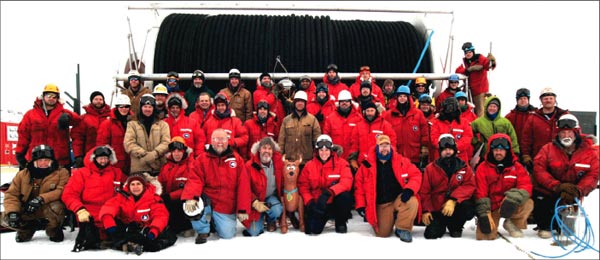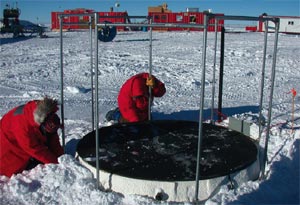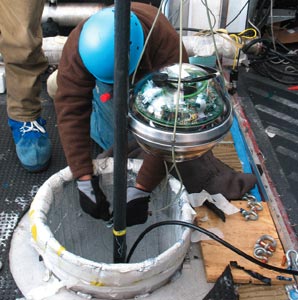After a successful construction season over the Austral summer at the South Pole, the IceCube detector array is now preparing to tackle real physics. Spencer Klein reports.

The second season of construction for the IceCube detector in Antarctica has recently ended as summer in the Southern Hemisphere has drawn to a close. Now with nine strings of sensors, IceCube is the largest neutrino detector in the world, and is well on the way to its goal of detecting extraterrestrial neutrinos with energies of more than 100 GeV.

By early February, eight strings, each comprising 60 optical sensors had been deployed, bringing the total number of in-ice sensors to 540. Each sensor includes a 25 cm photomultiplier tube in a pressure vessel. The associated electronics provides integrated trigger, readout, control, data-formatting and calibration functions, essentially forming a “mini-satellite”.

The strings form a triangular grid with 125 m sides, with the sensors installed 1450-2450 m below the surface, encompassing a volume of more than 3000 million tonnes of ice. A laser “standard candle” and a “dust-logger” to measure ice properties were also deployed. In addition, 24 IceTop tanks were installed, expanding the surface air-shower array to 32 tanks. The schedule was helped by generally good weather, with temperatures remaining above -30 °C until the end of January.

The season also saw the start of rapid production drilling, in which the heating system supplied hot water to one drill tower while a second tower was moved to the next hole. Although drilling got off to a late start, by the end of January holes were being drilled every four days, with string deployment smoothly following drilling. By the end of the season, it only took about 12 hours to connect the optical modules to the cable and lower the string into place. Strings were commissioned soon after deployment. About 99% of the detectors appear fully functional; the half-dozen or so failures stem from a variety of causes.
In addition to preparing for this season, IceCube has been collecting data from the single string and eight tanks that were deployed in 2004/05. Several different types of events have been studied: downward-going cosmic-ray muons, air showers and “flasher” events designed to mimic showers from the interactions of electron neutrinos. Flasher events are produced by the 12 LEDs contained in each sensor module. Events have also been studied that contain coincidences between the new strings and tanks, as well as between the new strings and the Antarctic Muon and Neutrino Detector Array (IceCube’s predecessor) and the South Pole Air Shower Array.
The initial data analyses included a search for neutrino events. Two clear muon neutrinos were observed, appearing as near-vertical, upward-going muons. One event was seen by 50 detectors, which tracked the muon over an 850 m trajectory. The other muon was observed by 35 sensors over about 650 m. These tracks correspond to minimum muon energies of about 420 and 330 GeV, respectively. The ratio of upward-going to downward-going muons is about 500,000:1; being able to separate clean neutrino events with a single string shows the power of the detector. Several additional possible candidates were observed with shorter tracks, with 8-11 hits. However, with a single string, these lower-multiplicity events could not be conclusively identified as neutrinos.
These data have been closely scrutinized to measure detector performance. Both the muon and light-flasher data demonstrate that the timing across the entire array (including the surface detectors) is consistent to better than 3 ns. The sensors are highly efficient for single photoelectrons, but also have adequate dynamic range to measure light pulses of up to 10,000 photoelectrons. Directional comparisons between air showers reconstructed with IceTop, and coincident muons seen in the deep ice were used to verify the pointing accuracy and angular resolutions. For muons, the angular resolution is better than 10° for events with 8 sensors hit, improving to 1.5° for events with more than 30 hits; the muon and neutrino directions are nearly co-linear.
The detector’s dark-noise rates are particularly important for supernova searches; a pulse of low-energy neutrinos from a supernova will manifest itself as an increase in the noise rates in the phototubes. Shortly after the phototubes were deployed, their noise rates rose dramatically owing to triboluminescence – light produced by friction as the ice freezes. However, after the freeze-in was complete, the phototube rates dropped to an average of 650 Hz. With 51 μs of deadtime after each pulse to remove correlated light, the rate drops to 350 Hz. This rate is even less than anticipated, increasing IceCube’s sensitivity to supernovae.
These successes bode well for the future of IceCube and physics analyses are now beginning. Working groups are forming to search for point sources of neutrinos, such as active galactic nuclei and gamma-ray bursters, to search for diffuse extra-terrestrial neutrinos and to study the composition of cosmic rays. IceCube will also shed light on many areas of nuclear and particle physics through searches for signs of supersymmetry, annihilation of weakly interacting massive particles in the Sun and Earth, and for exotica such as magnetic monopoles. It will also probe quantum chromodynamics, through a measurement of neutrino cross-sections at high energies (via absorption in Earth) and thereby explore saturation in nuclear-parton distributions at low parton energy fraction, i.e. low x. With a full programme of physics to explore, detailed plans for deployment are being made for the coming seasons, with at least 75 strings expected to be complete by 2011.
• IceCube is a collaboration of about 250 scientists and engineers from 30 institutions in the US, Europe, Japan and New Zealand. The $270 m project is funded largely by the US National Science Foundation, with smaller contributions from the US Department of Energy, the University of Wisconsin and several European countries.
Further reading
For more information about IceCube see www.icecube.wisc.edu or http://icecube.lbl.gov.
A Achterberg et al. 2005 astro-ph/0509330, papers presented at the 29th International Cosmic Ray Conference.





